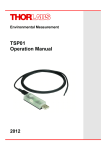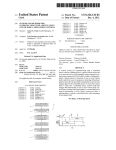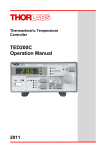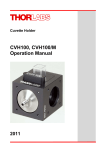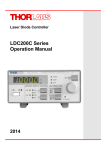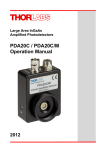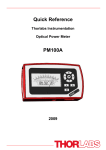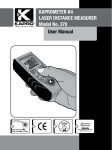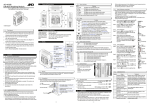Download PDA 200C Photodiode Amplifier
Transcript
Photo Diode Amplifier PDA200C Operation Manual 2012 Version: 3.0.7 Date: 13.08.2012 Copyright © 2012 Thorlabs Contents Foreword 2 1 General Information 3 1.1 Safety 1.2 Ordering Codes and Accessories 2 Installation 2.1 Parts List 2.2 Getting Started 3 Operating Instruction 3.1 Operating elements 3.2 Operation 3.2.1 Connecting a Photo Diode 3.2.2 Offset Adjustment 3.2.3 Calibration of the Power Display 3.2.4 Setting a BIAS Voltage 3.2.5 Analog Control Output 3.2.6 Disabling the Beeper 3 4 5 5 5 6 6 8 8 8 9 9 10 10 4 Maintenance and Service 11 4.1 Line Voltage Setting 4.2 Replacing Mains Fuses 4.3 Troubleshooting 11 12 13 5 Appendix 5.1 Technical Data 5.2 Certifications and Compliances 5.3 Thorlabs Worldwide Contacts 14 14 16 17 We aim to develop and produce the best solution for your application in the field of optical measurement technique. To help us to live up to your expectations and improve our products permanently we need your ideas and suggestions. Therefore, please let us know about possible criticism or ideas. We and our international partners are looking forward to hearing from you. Thorlabs GmbH Warning Sections marked by this symbol explain dangers that might result in personal injury or death. Always read the associated information carefully, before performing the indicated procedure. Attention Paragraphs preceeded by this symbol explain hazards that could damage the instrument and the connected equipment or may cause loss of data. Note This manual also contains "NOTES" and "HINTS" written in this form. Please read these advices carefully! 2 © 2012 Thorlabs 1 General Information 1 General Information The Thorlabs PDA200C is a precise, small photodiode amplifier to operate with all kinds of photodiodes. After calibration the PDA200C can be used as precise optical power meter. The photodiode amplifier PDA200C is excellently suited for: simple operation of photodiodes (transimpedance amplifier) sensitive pico-Ampère meter low noise amplification of photodiode current simple optical power meter The PDA200C is easy to use due to the clearly arranged front panel. The operating parameters are shown on an illuminated 5-digit LED display. Either PD-current, optical power or bias voltage can be displayed. The displayed parameter is chosen by up / down toggle switches and indicated by LEDs. The units of the measurement for current and power ranges are indicated by LEDs. The unit for bias voltage is V. With a 12-turn potentiometer the offset of the input amplifier and of the photodiode can be adjusted. With a sliding switch on the rear side of the PDA200C a bias voltage range of +0..+10 V (for polarity anode grounded) or -0..-10 V (for polarity cathode grounded) can be applied to the photodiode. The voltage is set with a 12-turn Potentiometer. With a 12-turn potentiometer the displayed power values can be calibrated for a known power level. A voltage proportional to the photodiode current is provided at an analog control output. The installed mains filter and the transformer shielding provide a low ripple at the analog control output. If requested Thorlabs offers calibrated photodiodes as accessories. 1.1 Safety Attention All statements regarding safety of operation and technical data in this instruction manual will only apply when the unit is operated correctly as it was designed for. Only with written consent from Thorlabs may changes to single components be carried out or components not supplied by Thorlabs be used. This precision device is only serviceable if properly packed into the complete original packaging including the plastic foam sleeves. If necessary, ask for a replacement package. Do not obstruct the air ventilation slots in housing! Do not remove covers! Refer servicing to qualified personnel! Before applying power to your PDA200C system make sure that the protective conductor of the 3 conductor mains power cord is correctly connected to the protective earth contact of the socket outlet! Improper grounding can cause electric shock with damages to your health or even death! Also make sure that the line voltage setting of the fuse holder at the rear panel agrees with your local supply and that the corresponding fuses are inserted. If not, please change the line © 2012 Thorlabs 3 PDA200C voltage setting 11 and the mains fuses 12 . The photodiode amplifier PDA200C must not be operated in explosion endangered environments! Photodiode input and analog output must only be connected with duly shielded connection cables. 1.2 Ordering Codes and Accessories Ordering code Short description PDA200C Photodiode amplifier / optical power meter Thorlabs offers a variety of photodiodes for different wavelengths and power ranges, which can be used with the PDA200C. Please visit our homepage http://www.thorlabs.com for further information. 4 © 2012 Thorlabs 2 Installation 2 Installation Geben Sie hier den Text ein. 2.1 Parts List Inspect the shipping container for damage. If the shipping container seems to be damaged, keep it until you have inspected the contents and you have inspected the PDA200C mechanically and electrically. Verify that you have received the following items within the package: 1. 2. 3. 4. 5. 1 PDA200C 1 grounding cable 1 flat-bladed screwdriver 1.8 x0.5 mm 1 power cord, connector according to ordering country 1 operation manual 2.2 Getting Started Prior to starting operation with the Photodiode Amplifier PDA200C, check if the line voltage set with the voltage selector at the rear panel agrees with your local supply and if the appropriate fuses are inserted (see sections Line Voltage Setting 11 and Replacing Mains Fuses 12 ) Connect the unit to the line with the provided mains cable. Turn the unit on by means of the line switch (F9). Via the connector jack of the chassis ground (R2) the external optical setup can be connected to ground potential, if required. The required grounding cable is attached. Note Grounding is strongly recommended in order to avoid hum and noise interference to the photo diode input, particularly when measuring low photo diode current. © 2012 Thorlabs 5 PDA200C 3 Operating Instruction 3.1 Operating elements Operating elements at front panel F1 F2 F3 F4 F5 F6 F7 F8 F9 F10 F11 F12 F13 F14 F15 F16 F17 F18 F19 F20 6 LED "nA" LED "µA" LED "mA" LED "nW" LED "µW" LED "mW" LED "BIAS ON” SET CAL LED “BIAS” LED "POPT" LED "IPD" Key "DOWN" Key "UP" Key Range ”Down” Key Range “Up” OFFSET PD INPUT 5-digit LED display Current display in nA Current display in µA Current display in mA Power display in nW Power display in µW Power display in mW Bias voltage switched on Line switch (ON / OFF) Potentiometer for setting the bias voltage Potentiometer for calibrating the power display "POPT" Display shows the bias voltage in volts Display shows the optical power Display shows the photodiode current Select the parameter to be displayed Select the parameter to be displayed Select the measurement range (increasing the sensitivity) Select the measurement range (decreasing the sensitivity) Potentiometer for PD input offset adjustment Photodiode input © 2012 Thorlabs 3 Operating Instruction Operating elements at rear panel R1 R2 R3 R4 R5 R6 Monitor control output "ANALOG OUT", 0 … ±10V 4 mm banana jack for grounding Selector switch for the photodiode bias voltage: CG (-) / OFF / AG (+) Serial number of the unit Indicator / switch for line voltage (included in fuse holder) Mains connector and fuse holder © 2012 Thorlabs 7 PDA200C 3.2 Operation Attention Prior to switch on the PDA200C please check if the line voltage setting (see the indicated voltage in the fuse holder's window R5 7 ) corresponds to your mains voltage! If the selected voltage does not match, please set it correctly as described in section “Line Voltage Setting 11 ”. Push the line switch (F10) to turn the unit on. After switching on the unit, the LED display (F1) and one of the LEDs, indicating the selected measurement value (F12 ... F14), lights up. If no display is shown, please check the line voltage setting and the mains fuses. Using up and down keys (F15) and (F16) the desired parameter can be selected. The PDA200C is immediately ready to use after turning on. The rated accuracy is reached, however, after a warming-up time of approx. 10 minutes. 3.2.1 Connecting a Photo Diode Photodiodes with both polarities can be used with the PDA200C. If a photodiode with anode connected to ground is used, the display (F1) shows a negative sign. Attention If the polarity of the photodiode is not known, first set the bias switch (R3) to zero to avoid damage to the diode! Select photo current display "IPD" using up / down keys F15) and F16). Select the 10 mA current (range keys F17 and F18). Connect the photodiode to the input jack "PD INPUT" (F20). Select an appropriate current range to show the actual photodiode current with the best resolution on the LED display. 3.2.2 Offset Adjustment The Offset Adjustment allows to compensate the input offset of the current amplifier or - if required - to zero the dark current of the connected photo diode. Offset and/or dark current adjustment is recommended to proceed after the PDA200C has warmed up. Offset compensation: Do not connect a photodiode to the input jack "PD INPUT" (F20). Select display IPD (F15/ F16). Select the 10 A current range (F17/ F18). Using the screwdriver coming with the PDA200C, turn the potentiometer "OFFSET" (F19) in order to achieve a zero IPD current in the display. It is not necessary to repeat the offset correction if you change the current range. 8 © 2012 Thorlabs 3 Operating Instruction Zeroing the PD's dark current Connect the photodiode to the input jack "PD INPUT" (F20) and make sure the PD is darkened completely. It might be useful to ground the photo diode's housing using the supplied grounding cable, connected to the GND jack R2 7 on the rear panel Select display IPD (F15/ F16). Select the required PD current range (F17/ F18). Using the screwdriver, turn the potentiometer "OFFSET" (F19) in order to achieve a zero IPD current in the display.Aftewr th Note After changing the IPD current range, the offset and dark current compensation must be repeated! 3.2.3 Calibration of the Power Display The PDA200C can be calibrated in order to display the optical power incident to the connected photodiode. The responsivity of the of the photodiode must not exceed the range 0.05 to 2 A/ W. If the connected PD has a responsivity exceeding this eange, please contact Thorlabs 17 for a solution. Connect the photodiode and turn the PDA200C on. Expose the photodiode to a well known optical power. Make sure that no additional optical power enters the photodiode. Select display IPD (F15 / F16). Select an appropriate current range (F17 / F18) to show the actual photodiode current with the best possible resolution. Select display POPT (F15 / F16). Use the screwdriver to adjust the potentiometer "CAL" (F11) in order to get the value of the optical power POPT displayed equal to the known power level. This calibration is valid for all current ranges of the PDA200C. 3.2.4 Setting a BIAS Voltage The PDA200C provides the possibility to apply a reverse voltage of up to ±10 V (bias) to the photodiode (photo-conductive mode). Set the bias switch (R3 7 ) to “OFF” Connect the photodiode and turn on the PDA200C Expose the photodiode to light. Select the current range (F17 / F18). If the displayed value is positive (polarity cathode grounded), set the bias switch (R3) to " CG". The applied bias voltage is negative. If the displayed value is negative (polarity anode grounded), set the bias switch (R3) to " + AG". The applied bias voltage is positive. Select Display “Bias” (F15 / F16). The bias voltage is displayed in volts. © 2012 Thorlabs 9 PDA200C Use the screwdriver to set the potentiometer "SET" (F10) to the desired value for the bias voltage. Attention If the polarity of the bias does not match to the photodiode polarity, the bias voltage may damage the photodiode. If the bias voltage exceeds the reverse voltage rating of the photodiode, the bias voltage may damage the photodiode 3.2.5 Analog Control Output The analog output "ANALOG OUT" (R1 7 ) at the rear panel delivers a DC voltage proportional to the display reading of photodiode current IPD. The output voltage is 0 …+10 V for a display reading of 0 … 10000 (photodiode cathode grounded) or 0 … -10 V for a display reading of 0 … -10000 (photodiode anode grounded). The maximum bandwidth of the monitor output "ANALOG OUT" (R1) depends on the current range (see Technical Data 14 ). The shield of the BNC "ANALOG OUT" (R1) is grounded. Thus an oscilloscope or PC based AD-Converter or other recording devices can be connected directly. Take care to avoid ground loops. Devices connected to these outputs should have an input resistance 10 k. 3.2.6 Disabling the Beeper If audible signals are unwanted, the beeper can be disabled: Press and hold key “Up” (F16), then toggle beeper status using the key “Down” (F15). Now the beeper state is displayed: “Sd.On” Sound ON “Sd.OFF” Sound OFF 10 © 2012 Thorlabs 4 Maintenance and Service 4 Maintenance and Service Protect the PDA200C from adverse weather conditions. The PDA200C is not water resistant. Attention To avoid damage to the instrument, do not expose it to spray, liquids or solvents! The unit does not need a regular maintenance by the user. It does not contain any modules and/or components that could be repaired by the user himself. If a malfunction occurs, please contact Thorlabs 17 for return instructions. Do not remove covers! If necessary the unit and the display can be cleaned with a cloth dampened with water. You can use a mild 75% Isopropyl Alcohol solution for more efficient cleaning. It is recommended to have the unit calibrated by Thorlabs every two years. 4.1 Line Voltage Setting The Photodiode Amplifier PDA200C operates at fixed line voltages of 100 V +15% / -10% (90 V … 115 V), 115 V +15%/ -10% (104 V … 132 V) or 230 V +15%/ -10% (207 V … 264 V), line frequency 50 … 60 Hz. The line voltage setting can be changed from the rear without opening the unit: 1. Turn off the PDA200C and disconnect the mains cable. 2. The fuse holder R7 (see Operating Elements 7 ) is located below the 3-pole power connector of the mains jack (R6). Release the fuse holder by pressing its plastic retainers with the aid of a small screwdriver. The retainers are located on the right and left side of the holder and must be pressed towards the center. 3. Detach white line voltage switch / indicator (R5, containing the left fuse) from the fuse holder (R7), rotate it until the appropriate voltage marking (100V, 115V, or 230V) is visible in the aperture (R9) of the fuse holder, and plug it back into the fuse holder. Press in the fuse holder until locked on both sides. The appropriate line voltage marking must be visible in the cutout (R9) of the fuse holder. Attention If the line voltage was changed, make sure the mains fuse is of the correct value (See next section 12 of this manual). © 2012 Thorlabs 11 PDA200C 4.2 Replacing Mains Fuses The two power input fuses are externally accessible. If they have opened due to line distortions, incorrect line voltage or other causes, they can be replaced from the rear without opening the unit. Attention To avoid risk of fire only the appropriate fuses for the corresponding line voltage must be used. 1. Turn off the PDA200C and disconnect the mains cable. 2. The fuse holder (R7, see figure below) is located below the 3-pole power connector of the mains jack (R6). Release the fuse holder by pressing its plastic retainers using a small screwdriver. The retainers are located on the right and left side of the holder and must be pressed towards the center. 3. Replace the defective fuses (R8) and press in the fuse holder until locked on both sides. Take care to maintain the correct rotation of the white line voltage indicator / switch (R5) which contains the left fuse and is plugged into the fuse holder. The appropriate line voltage marking must be visible in the cutout (R9) of the fuse holder. Fuse types 100 V 500 mA, time-lag, 250V T0.5A 250V 115 V 500 mA, time-lag, 250V T0.5A 250V 230 V 250 mA, time-lag, 250V T0.25A 250V All fuses must meet IEC specification 60127-2/III, time characteristic: time-lag (T), 250V AC, size 5 x 20 mm. 12 © 2012 Thorlabs 4 Maintenance and Service 4.3 Troubleshooting Unit does not work at all (no display at the front): PDA200C connected properly to the mains? Check the mains cable and the line voltage setting (please refer to section Line Voltage Setting 11 ). PDA200C turned on? Turn on your PDA200C with the key mains-switch. Check the fuses at the rear panel (see Replacing Mains Fuses 12 ). If blown replace the fuses by the correct type (select the appropriate fuse type) The measured photo current or optical power seem to be not correct Are all offset errors eliminated? See "Offset Adjustment 8 " for compensation Is the photodiode calibrated? See "Calibration of the Power Display 9 ". Was the dark current of the photodiode compensated and subsequently the measurement range changed? Repeat the dark current calibration using. 9 for the actual measurement range you are Measurement results are unstable Check system setup for possible ground loops which may introduce line interferences (50/60 Hz) into your setup. Check if grounding of the PD housing (using the supplied grounding cable) improves noise and / or hum. The unit switches on, but display shows error message (e.g., “Err06”) This indicates a malfunction of the PDA200C. In such case, the controller needs to be returned to Thorlabs for maintenance. Please contact Thorlabs 17 with the information of the error code number and the serial number of your PDA200C in order to receive the RMA (Return Material Authorization) instructions accordingly. If you don’t find the error source by means of the trouble shooting list please contact Thorlabs 17 for advise and/or return instructions. © 2012 Thorlabs 13 PDA200C 5 Appendix 5.1 Technical Data Specifications Full Scale Current Measurement Ranges Maximum Resolution Display Range Polarity of the Photodiode Bias Voltage Photodiode Sensitivity (for Calibrated Power Display) Max. Photodiode Capacitance for Frequency Compensated Operation Temperature Coefficient Input Impedance Output Voltage Range (Analog Output) Noise (rms f.s.of current measurement range) Load Resistance 100 nA to 10 mA (in Decade Steps) 10 pA 0 to 10000 (CG), 0 to -10000 (AG) Cathode Grounded (CG) or Anode Grounded (AG) 0 to -10 V (CG), 0 to +10 V (AG) 0.05 to 2 A/W 10 nF <50 ppm/°C ~0 Ω (Virtual Ground) 0 to +10 V (CG), 0 to -10 V (AG) ≥0.02% >10 kΩ Spec Typ 4 Display Connectors (PD Input, Analog Output) Chassis Ground Connector Line Voltage Line Frequency Maximum Power Consumption Warm-up Time for Rated Accuracy LED, 5 Digits BNC 4 mm Banana Jack 100 V 115 V ( +15% -10%) 230 V 50 to 60 Hz 10 VA 10 min General Operating Temperature Range 1) Storage Temperature Range 0 - 40 °C -40 to 70 °C Dimensions (W x H x D), w/o operating elem. 146 x 66 x 290 mm³ Dimensions (W x H x D), with operating elem. 146 x 77 x 320 mm³ Weight 1) <3 kg non-condensing All technical data are valid at 23 ± 5°C and 45 ± 15% rel. humidity (non condensing) 14 © 2012 Thorlabs 5 Appendix Current range Resolution Amplification Accuracy Bandwidth ) 10 mA 1 mA 1 x 103 V/A ± 0.05 % f.s. 500 kHz 1 mA 100 nA 1 x 104 V/A ± 0.05 % f.s. 250 kHz 100 mA 10 nA 1 x 105 V/A ± 0.05 % f.s. 70 kHz 10 mA 1 nA 1 x 106 V/A ± 0.05 % f.s. 20 kHz 1 mA 100 pA 1 x 107 V/A ± 0.05 % f.s. 5 kHz 100 nA 10 pA 1 x 108 V/A ± 0.1 % f.s. 1 kHz © 2012 Thorlabs 15 PDA200C 5.2 Certifications and Compliances Category Standards or description EC Declaration of Conformity - EMC Meets intent of Directive 2004/108/EC 1 for Electromagnetic Compatibility. Compliance was demonstrated to the following specifications as listed in the Official Journal of the European Communities: EN 61326:1997 Electrical equipment for measurement, control and laboratory use – +A1:1998 +A2:2001 EMC requirements: +A3:2003 Immunity: complies with immunity test requirements for equipment intended for use in industrial locations 2. Emission: complies with EN 55011 Class B Limits 2,3 IEC 61000-3-2 and IEC 61000-3-3. IEC 61000-4-2 Electrostatic Discharge Immunity (Performance Criterion A) IEC 61000-4-3 Radiated RF Electromagnetic Field Immunity (Performance Criterion A) IEC 61000-4-4 Electrical Fast Transient / Burst Immunity (Performance Criterion A) IEC 61000-4-5 Power Line Surge Immunity (Performance Criterion A) IEC 61000-4-6 Conducted RF Immunity (Performance Criterion A) IEC 61000-4-11 Voltage Dips, Short Interruptions and Voltage Variations Immunity (Performance Criterion A/C4) AC Power Line Harmonic Emissions Voltage Fluctuations and Flicker IEC 61000-3-2 IEC 61000-3-3 FCC EMC Compliance Emissions comply with the Class B Limits of FCC Code of Federal Regulations 47, Part 15, Subpart B 3,4. EC Declaration of Conformity - Low Voltage Compliance was demonstrated to the following specification as listed in the Official Journal of the European Communities: Low Voltage Directive 2006/95/EC 5 EN 61010-1:2001 U.S. Nationally Recognized Testing Laboratory Listing UL 61010-1 2nd ed. Canadian Certification CAN/CSA C22.2 No. 61010-1-04 Additional Compliance IEC 61010-1:2001 Equipment Type Test and Measuring Safety Class Class I equipment (as defined in IEC 60950-1:2001) ISA-82:02.01 Safety Requirements for Electrical Equipment for Measurement, Control and Laboratory Use - Part 1: General Requirements 1 Replaces 89/336/EEC. 2 Compliance demonstrated using high-quality shielded interface cables shorter than or equal to 3 meters. 3 Emissions, which exceed the levels required by these standards, may occur when this equipment is connected to a test object. 4 Performance Criterion C was reached at additional test levels according to EN 61326-1:2006 table 2. 5 Replaces 73/23/EEC, amended by 93/68/EEC 16 © 2012 Thorlabs 5 Appendix 5.3 Thorlabs Worldwide Contacts USA, Canada, and South America Thorlabs, Inc. 56 Sparta Avenue Newton, NJ 07860 USA Tel: 973-579-7227 Fax: 973-300-3600 www.thorlabs.com www.thorlabs.us (West Coast) Email: [email protected] Support: [email protected] Europe Thorlabs GmbH Hans-Böckler-Str. 6 85221 Dachau Germany Tel: +49-8131-5956-0 Fax: +49-8131-5956-99 www.thorlabs.de Email: [email protected] UK and Ireland Thorlabs Ltd. 1 Saint Thomas Place, Ely Cambridgeshire CB7 4EX United Kingdom Tel: +44-1353-654440 Fax: +44-1353-654444 www.thorlabs.com Email: [email protected] Support: [email protected] France Thorlabs SAS 109, rue des Côtes 78600 Maisons-Laffitte France Tel: +33-970 444 844 Fax: +33-811 38 17 48 www.thorlabs.com Email: [email protected] Scandinavia Thorlabs Sweden AB Mölndalsvägen 3 412 63 Göteborg Sweden Tel: +46-31-733-30-00 Fax: +46-31-703-40-45 www.thorlabs.com Email: [email protected] Japan Thorlabs Japan, Inc. Higashi Ikebukuro Q Building 2nd Floor 2-23-2 Toshima-ku, Tokyo 170-0013 Japan Tel: +81-3-5979-8889 Fax: +81-3-5979-7285 www.thorlabs.jp Email: [email protected] China Thorlabs China Room A101, No. 100 Lane 2891, South Qilianshan Road Putuo District Shanghai 200331 China Tel: +86-21-60561122 Fax: +86-21-32513480 www.thorlabs.hk Email: [email protected] © 2012 Thorlabs 17 PDA200C Thorlabs 'End of Life' Policy (WEEE) As required by the WEEE (Waste Electrical and Electronic Equipment Directive) of the European Community and the corresponding national laws, Thorlabs offers all end users in the EC the possibility to return “end of life” units without incurring disposal charges. This offer is valid for Thorlabs electrical and electronic equipment • sold after August 13th 2005 • marked correspondingly with the crossed out “wheelie bin” logo (see figure below) • sold to a company or institute within the EC • currently owned by a company or institute within the EC • still complete, not disassembled and not contaminated. As the WEEE directive applies to self contained operational electrical and electronic products, this “end of life” take back service does not refer to other Thorlabs products, such as: • pure OEM products, that means assemblies to be built into a unit by the user (e. g. OEM laser driver cards) • components • mechanics and optics • left over parts of units disassembled by the user (PCB’s, housings etc.). Waste treatment on your own responsibility If you do not return an “end of life” unit to Thorlabs, you must hand it to a company specialized in waste recovery. Do not dispose of the unit in a litter bin or at a public waste disposal site. WEEE Number (Germany) : DE97581288 Ecological background It is well known that waste treatment pollutes the environment by releasing toxic products during decomposition. The aim of the European RoHS Directive is to reduce the content of toxic substances in electronic products in the future. The intent of the WEEE Directive is to enforce the recycling of WEEE. A controlled recycling of end-of-life products will thereby avoid negative impacts on the environment. Crossed out "Wheelie Bin" symbol 18 © 2012 Thorlabs 5 Appendix Warranty Thorlabs warrants material and production of the PDA200C for a period of 24 months starting with the date of shipment. During this warranty period Thorlabs will see to defaults by repair or by exchange if these are entitled to warranty. For warranty repairs or service the unit must be sent back to Thorlabs. The customer will carry the shipping costs to Thorlabs, in case of warranty repairs Thorlabs will carry the shipping costs back to the customer. If no warranty repair is applicable the customer also has to carry the costs for back shipment. In case of shipment from outside EU duties, taxes etc. which should arise have to be carried by the customer. Thorlabs warrants the hard- and software determined by Thorlabs for this unit to operate fault-free provided that they are handled according to our requirements. However, Thorlabs does not warrant a fault free and uninterrupted operation of the unit, of the software or firmware for special applications nor this instruction manual to be error free. Thorlabs is not liable for consequential damages. Restiction of Warranty The warranty mentioned before does not cover errors and defects being the result of improper treatment, software or interface not supplied by us, modification, misuse or operation outside the defined ambient stated by us or unauthorized maintenance. Further claims will not be consented to and will not be acknowledged. Thorlabs does explicitly not warrant the usability or the economical use for certain cases of application. Thorlabs reserves the right to change this instruction manual or the technical data of the described unit at any time. © 2012 Thorlabs 19 PDA200C Copyright Thorlabs GmbH has taken every possible care in preparing this Operation Manual. We however assume no liability for the content, completeness or quality of the information contained therein. The content of this manual is regularly updated and adapted to reflect the current status of the software. We furthermore do not guarantee that this product will function without errors, even if the stated specifications are adhered to. Under no circumstances can we guarantee that a particular objective can be achieved with the purchase of this product. Insofar as permitted under statutory regulations, we assume no liability for direct damage, indirect damage or damages suffered by third parties resulting from the purchase of this product. In no event shall any liability exceed the purchase price of the product. Please note that the content of this User Manual is neither part of any previous or existing agreement, promise, representation or legal relationship, nor an alteration or amendment thereof. All obligations of Thorlabs GmbH result from the respective contract of sale, which also includes the complete and exclusively applicable warranty regulations. These contractual warranty regulations are neither extended nor limited by the information contained in this User Manual. Should you require further information on this product, or encounter specific problems that are not discussed in sufficient detail in the User Manual, please contact your local Thorlabs dealer or system installer. All rights reserved. This manual may not be reproduced, transmitted or translated to another language, either as a whole or in parts, without the prior written permission of Thorlabs GmbH. Status: 2012 Copyright © Thorlabs GmbH. All rights reserved. 20 © 2012 Thorlabs






















